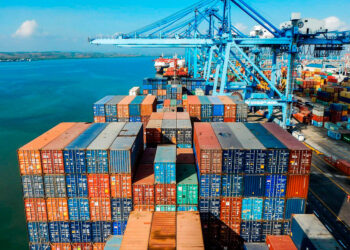Uganda’s finance minister has announced that the country has entered into an agreement with the Islamic Development Bank (IDB) of Saudi Arabia for a $295 million loan to support various projects, including road construction.
According to Reuters, the move highlights Uganda’s effort to diversify its source of external funding as talks with the World Bank to resume lending have been unsuccessful.
The major initiatives in consideration include the Masindi-Port Bridge, which facilitates the crossing of the River Nile by ferry and links to the Renkunye-Apac-Lira Road. Additionally, there is the Kyenjojo-Kihura-Bwizi-Rwamwanja-Kahunge(68km)/Mparo-Bwizi (37km) Road, which connects Kamwenge town to the Kampala Fort Portal Highway.
READ MORE: Dr Arikana, Enabulele, Others Team Up For Ubuntu Awakening Summit
According to a post made on X by Ugandan Finance Minister, Matia Kasaija, the loan was signed after agreement was reached with IDB President, Muhammad Al Jassar, in Saudi Arabia’s capital, Riyadh.
The loan will go to the funding of roads in the country totaling 105km and a bridge crossing the River Nile in North West Uganda.
The finance minister on behalf of the Ugandan government thanked the Islamic Development Bank for the cordial cooperation that exists between the Bank and the government of Uganda.
He also thanked the Development Bank for establishing a regional hub in Kampala.
The finance minister has also entered into a framework agreement with the Islamic Trade Finance Corporation (ITFC), a subsidiary of the Islamic Development Bank, in order to streamline trade in Uganda.
What To Know
- The World Bank, traditionally Uganda’s biggest external lender, suspended new loans to the country after the enactment of a harsh anti-homosexuality law.
- The Islamic Development Bank is the third largest multilateral donor to Uganda contributing over 20% support in areas of roads, energy & education.
- Muslims in Uganda constitute 14% of the total population.
Uganda’s Public Debt Dilemma
Uganda’s public debt has risen to unprecedented levels, reaching shillings (UGX) 96.1 trillion ($25.3 billion or 52 percent of GDP) as of June 2023, according to an Auditor General’s report released recently. Of this 44.6 trillion is domestic while 52.8 trillion is from foreign sources. This amount excludes the UGX 7 trillion worth of loans pending approval by Parliament. Each of the 45 million Ugandans is now indebted to the tune of UGX 2.5 million. Rising public debt coupled with growing debt servicing costs, stagnating domestic tax revenues, and declining export revenues are putting Uganda in debt distress and at greater risk of debt crisis.
Uganda faces a critical financial challenge as interest payments on loans now consume a significant portion of the budget and domestic revenues. According to the December 2023 report from the Bank of Uganda, escalating debt servicing costs are straining tax revenue collection, with UGX 32 out of every UGX 100 collected going towards debt service. The Bank of Uganda projects that external debt servicing will account for 35 percent of GDP in 2024/2025. However, this is not unique to Uganda. According to a recent International Debt Report by the World Bank, “record debt levels coupled with high-interest rates have set many countries on a path to crisis”. The report further notes that “every quarter that interest rates stay high, results in developing countries becoming distressed – and facing the tough choice of servicing their debts or investing in public health, education or infrastructure”.
Multiple factors, such as a shift in spending toward infrastructure and the impact of the COVID-19 pandemic, explain the recent rise in Uganda’s public debt. Before the pandemic, public debt was 34.6 percent of GDP in 2018/2019 but surged to 50.6 percent in 2021/2022 and is projected to reach 53 percent in 2023/2024. This surpasses the IMF’s recommended threshold of 50 percent for low-income countries. A drop in aid, budget support and development assistance from development partners due to passage of anti-gay law from 2.781 trillion to 28.94 billion has further contributed to increased borrowing to finance the gap. Acquisition of non-concessional loans to fund current expenditures, as well as new debt for Budget support coupled with growing gap between revenues and expenditures has always meant government has to borrow to finance the deficit. Rollover of previous debt and bond switches adds to the burden.
Other shocks, such as global fluctuations in interest and exchange rates, are also contributing to the rise in Uganda’s external debt due to foreign currency exposure. A depreciating domestic currency increases the value of foreign currency-denominated debt, exacerbating the external debt burden.
Rising public debt has led to growing public anxieties and sparked concerns about potential sovereign default and a debt crisis if the current trend is not promptly addressed. High debt levels hamper economic growth and curtail public and private investment. They also divert crucial resources away from delivering social services, resulting in disproportionate spending on debt at the expense of vital sectors such as infrastructure, labor productivity, human capital, and public health. Sluggish tax revenue collection exposes Uganda to debt servicing vulnerabilities. Over the medium term, declining domestic revenues may push Uganda’s debt beyond the current level of 52 percent of GDP.
If Uganda’s current public debt trends are not controlled, debt financing turbulences could emerge in 2024. Growing evidence suggests that Uganda may become caught up in a “public debt safety trap” where a favorable debt position, largely based on traditional debt sustainability metrics, falsely signals that the country has more fiscal headroom to borrow, especially when debt is still below the set national or international limit.










